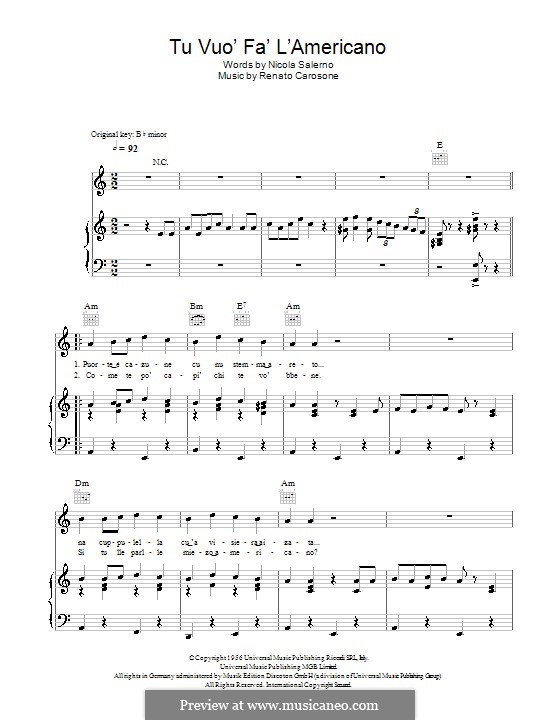

The written lyrics are somewhat wrong, just a few words here and there I guess this was an unpolished version and that it was redone a couple weeks later, when it became a meme. Not my “true” voice, mind you: it’s pitched up a few tones. Oh, btw: I’m a language nerd, the singer in this parody, and the Official Singing Voice for Gino The Chicken. I can’t believe I’m stumbling on this 18 years after the “fact” – and that somebody would still listen to this in 2012. Will anybody ever read this? Oh well, whatever. Understand, Osama, you want to be a Taleban Tu vuo’ fa ‘o talebano, talebano, talebano, You Want to Be a Taliban Tienni la barba longa chiu’ d’un metro, Today a reader comment on my translation of Tu Vuo’ Fa’ L’Americano directed me to YouTube, where I ran across Gino’s version of the song, directed at Osama bin Laden: He combined Tarantella with African and American rhythms and was, along with Domenico Modugno, the only Italian artist to sell his music in the United States without recording it in English.“Gino the Chicken” was a phenomenon in Italy a few years ago. Four hundred thousand people attended his funeral in Piazza del Popolo.Īn extraordinary pianist, classical and jazz performer, Renato Carosone remains one of the greatest interpreters of modern Neapolitan music. Renato Carosone died on Sunday in his home in Rome. Ripley by Anthony Minghella, in which the actors Rosario Fiorello, Matt Damon, and Jude Law got wild in a nightclub dancing Tu vuo' fa l'americano.
#Tu vuo fa l americano translation movie#
In 1999, the United States paid homage to the Italian artist – already suffering from respiratory and circulatory problems – through the movie The Talented Mr. However, his strong character would made him overcome the disease and dedicate himself to music and to his other great passion, painting, nurtured until his death. He was then urgently hospitalized in the neurosurgery department of San Camillo hospital in Rome and underwent a delicate operation. On 15 March 1993, Carosone had an intracranial aneurysm. On 9 August 1975, after 15 years of retirement, Carosone came back to the stage with a band of 19 people and a televised show. Some scandal-seeking newspapers of the time wrote about religious reasons lying behind this choice. The group performed in Caracas, Rio de Janeiro, and, on 6 January 1958, in New York at the prestigious Carnegie Hall, which up until then had been reserved to classical music – only exception being the jazz clarinet player Benny Goodman and his quartet's performance in 1938.Īt the height of his career, on 7 September 1959, Carosone unexpectedly retiremed from music.
#Tu vuo fa l americano translation series#
It was translated into 12 languages and 32 cover versions were recorded in the US.Īfter a series of concerts in Europe, the sextet – which now included the drummer Aldo Pagani – landed in Cuba, starting off a memorable American tour.

For 14 weeks, Torero remained at number 1 on the US hit parade. In 1957, he wrote his and Nisa's greatest success: Torero. The trio would subsequently comprise the singer Piero Giorgetti to then turn into a six-person group.Ĭarosone's sextet exhibited in an international tour in 1956. In 1956, Carosone met the lyricist Nisa (his real name being Nicola Salerno), with whom he would establish a long-lasting friendship. Besides Maruzzella, Carosone's songs are primarily inspired by the rich repertoire of Neapolitan hits such as Malafemmena by Totò and Anema e Core, which he reinvented according to his personal taste and rhythmic style. The artist's first commercial success was the song Maruzzella, composed by him in 1954, on a text by Enzo Bonagura.

He signed the Dutch guitarist Peter Van Wood, the introducer of the guitar pedal board, and Gegè di Giacomo, nephew of the famous Neapolitan poet Salvatore di Giacomo. In 1949, Carosone was asked to put together a trio for the Shaker club in Naples. On August 1937, he landed in Eritrea: he would stay in Addis Ababa working as orchestra leader until the outbreak of the First World War, when he was called up to fight in Somalia. He graduated in piano at the Conservatorio di Napoli in the church of Saint Peter in Majella, at the age of seventeen.Ĭarosone's first relevant experience took place in Africa. Renato Carosone (Naples, 3 January 1920) studied piano from a young age, encouraged by the will of his father, who was a theatrical impresario and a mandolin player. His smiling face while playing the piano, as it were an easy job, reveals Carosone's slight greatness. One can easily recognize the unmistakable smile of Renato Carosone. Author : Giovanni Verde Translation by: Giulia Carletti


 0 kommentar(er)
0 kommentar(er)
